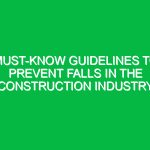“`html
Essential Guidelines to Prevent Falls on the Same Level: Stay Safe!
Good morning team! Today, we’re going to talk about an important Safety topic that affects all of us: preventing falls on the same level. Falls can happen anywhere, whether you’re in the warehouse, on the production floor, or in the office. Understanding how to stay safe is crucial for protecting ourselves and our colleagues. Let’s dive into why this topic is vital for our Workplace Safety.
Understanding Falls on the Same Level
Falls on the same level refer to incidents where a person trips, slips, or loses their balance on a flat surface, leading to a fall. These falls can result in serious injuries, including sprains, fractures, and even concussions. According to OSHA, slips, trips, and falls are among the leading causes of workplace accidents. It’s essential to recognize that even a simple fall can have significant consequences for our health and productivity.
Many people believe that falls only occur from heights, but that’s a misconception. Falls on the same level are just as dangerous and can happen to anyone, regardless of their experience or environment. Being aware of this reality can help us take the necessary Precautions to prevent such incidents.
Key Hazards, Risks, and Safety Considerations
Let’s take a closer look at some specific Hazards and risks associated with falls on the same level:
- Wet or Slippery Surfaces: Spills, rain, or cleaning activities can create slippery areas that increase the risk of falls.
- Uneven Surfaces: Cracks, potholes, and uneven flooring can be tripping hazards that lead to falls.
- Cluttered Workspaces: Tools, materials, or equipment left in walkways can obstruct paths and cause trips.
- Improper Footwear: Shoes without adequate grip or support can increase the likelihood of slipping.
Ignoring these hazards can lead to serious injuries, affecting not only the injured party but also the entire team due to lost productivity and increased insurance costs. It’s crucial to recognize these risks and take actionable steps to mitigate them.
Best Practices, Procedures, & Actionable Advice
Now, let’s discuss some Best Practices to prevent falls on the same level:
1. Maintain Clean Work Areas
Keeping work areas tidy is one of the simplest yet most effective ways to prevent falls. Ensure that:
- Walkways are clear of clutter and equipment.
- Spills are cleaned up immediately and marked with caution signs until dry.
- Tools and materials are stored properly after use.
2. Use Anti-Slip Mats
In areas prone to moisture, using anti-slip mats can provide additional grip and reduce the risk of slipping. These mats are especially useful in kitchens, restrooms, and entryways.
3. Inspect Floors Regularly
Conduct regular inspections of floors for cracks, holes, or any other irregularities. Report any issues immediately so they can be repaired promptly.
4. Wear Proper Footwear
Encourage all employees to wear footwear that provides good traction and support. This simple measure can significantly reduce the risk of slips and falls.
5. Be Mindful of Your Surroundings
Always be aware of your environment. Look where you are walking and avoid distractions, such as using your phone while moving around.
6. Implement Safety Signage
Use clear signage to indicate potential hazards, such as wet floors or uneven surfaces. Visibility is key in helping everyone stay alert to possible dangers.
7. Conduct Safety Training
Regular safety training sessions should be held to educate employees on the risks of falls and the proper safety protocols to follow. Real-life examples and case studies can enhance understanding.
Regulations, Standards, and Compliance
It’s essential to stay compliant with relevant safety Regulations, such as those set by osha. OSHA mandates that employers provide a safe working environment, which includes taking steps to prevent falls on the same level. Familiarizing yourself with these regulations helps ensure that our workplace meets safety Standards and protects everyone.
Employee Engagement & Discussion
Now, I’d like to open the floor for discussion. What safety challenges have you encountered related to falls on the same level? Have you seen any hazards that we might have overlooked? Sharing our experiences can help us learn from one another and improve our safety practices.
Conclusion & Key Takeaways
To summarize, preventing falls on the same level is a shared responsibility that requires vigilance and proactive measures. Remember to maintain clean work areas, use proper footwear, and be aware of your surroundings. By applying these guidelines, we can create a safer workplace for everyone.
Thank you for your attention and commitment to safety. Let’s prioritize our health and well-being every day!
“`


